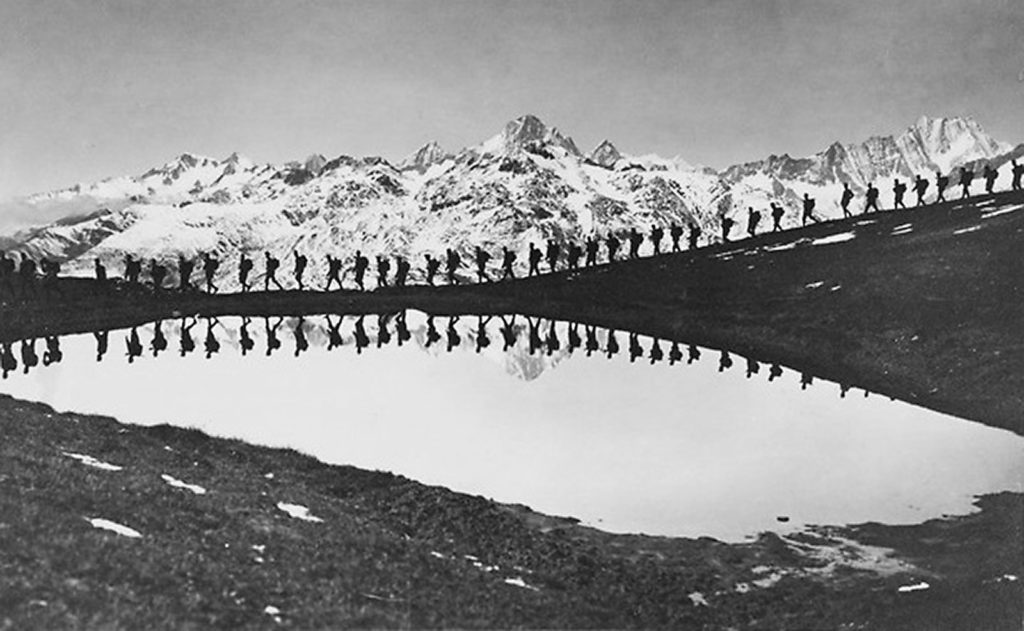Although everybody thinks they know to some extent what it means to unionize, nobody knows precisely what legal, economic or social flux might be generated, increased or halted by union activity. Nor do we know beyond, or perhaps despite, all the visible forms of unionizing (mobilizations, declarations, petitions, assignments) what greater collection of gestures and relationships might modify the texture of reality and set new norms to counter the instrumental logic of numbers and statistics. An essay by writer and trade unionist Laurent Quintreau.
Judith Butler, Rassemblement Pluralité, performance et politique (Fayard, 2016).
David Graeber, Bureaucratie, l’utopie des règles (Les Liens qui Libèrent, 2015)
Herbert Marcuse, L’homme unidimensionnel (Editions de Minuit, 1968)
Philippe Lorino et Michel Sailly, Lean (Séminaire n° 35 de l’Observatoire des cadres, cfdt cadres, 2014)
Micea Eliade, Le chamanisme ou les techniques archaïques de l’extase (Bibliothèque historique Payot, 2007)
Harmut Rosa, Accélération, Une critique sociale du temps (La Découverte, Paris 2010)
Frédéric Gros, Désobéir (Albin Michel, 2017)
Valérie Charolles, Philosophie de l’écran : dans le monde de la caverne (Fayard, 2014)
Théodore Adorno, Minima moralia : Réflexions sur la vie mutilée (Payot, 2016)
Frédéric Lordon, La société des affects. Pour un structuralisme des passions (Editions du Seuil, 2013)
Marcel Duchamp, Entretiens avec Pierre Cabanne (Allia, 2014)
Nicolas Bourriaud, Formes de vie, l’art moderne ou l’invention de soi (Denoël, 2003)
A silent ecosystem
A human machine working for the collective, unions can establish a foundation for rights and security nets for all of society. The same can also be said for the sectors of social welfare and education, which in Scandinavia, Germany or France are administered by joint bodies in which equal numbers of employers and employees can debate, discuss and self-regulate. And the same goes too for any place where unions operate to establish, alongside representatives from the management, workplace justice, basic salary minima, or settle disputes regarding work-related illness or injury: in labor court, collective bargaining commissions, the social security tribunal…
Unlike the spheres of politics or show business, where nothing can be done without media hyper-visibility and inflated egos, unions operate for millions of people in silence and anonymity, remaining loyal to the word’s etymology1. Crossing a number of areas of expertise, trade unions create gaps and draw lines between disciplines and fields of knowledge (law, sociology, psychology, accounting…) in order to arm the collective indignation against certain aspects of reality. Then it is up to them to find the best gesture, the formula that suits their intentions, whether it concerns worker’s health, career stability and job security, or the quality of life in the workplace.
Touchstones of this erasure of me before the we, union leaders (elected by different strata of the organization to which they must answer) are often extremely discrete about their private lives. At a time when just about any ministry underling is inclined to exhibit him- or herself in the gossip columns, it is still relatively unlikely that one would see the General Secretary of a large union in the pages of People.
Aligned along ‘a form of reactivity that involves a dispossession of egology’, as Judith Butler2 puts it, unions adapt to complex environments (notwithstanding the eternal refrain about low membership rates in Latin countries; rates which do not take into account the union’s instances in court, the rate of coverage for salaried workers following branch or company agreements, or the beneficiaries of a union action, be it through disputes or simple counsel). In places of poverty, unions survive as a representation for the Demos—in authoritarian or theocratic regimes where protesting can lead to prison, if not the scaffold—it gets minority voices heard, or even the voice of a majority silently longing for another kind of work life and society.
Wherever it exists, the union counterforce participates in the social ontology and nourishes its questions with pragmatic content: Why is there something rather than nothing? How can we build a world that won’t collapse a few days later? With the power of praxis, re-affirmed by the percentages of votes won through professional elections and by the full discharge granted through assemblies, unionizing can provide a legitimate answer to the Kantian-Leninist question: what is to be done?
« What could be less joyful than this hysteria for racing to the finish lines, pushing beyond capacity, with its site indicators instead of reflection and a “bureaucratization of the world” »
Creating new balances
The last few decades of pressure from international competition, financial markets and digital technologies have indeed set the stage for all kinds of excesses and extremes: rising wage inequality between the lowest and highest earners, a frenzy of quantified processes and objectives assigned to everyone leading to a general degradation of work conditions and all the disorders that accompany it—suicides, psycho-social risks, burn out. What could be less joyful than this hysteria for racing to the finish lines, pushing beyond capacity, with its site indicators instead of reflection and a “bureaucratization of the world”3 that produces tons of regulations and forms benefiting a minority of people and leading both mankind and the planet to the brink of exhaustion?
Rather than channel us toward a platonic dream, this love for numbers and figures has pushed humankind and nature to accelerate their own disappearance. And for the most part, a diverse range of economic drivers involved in this insane race are in it despite themselves. On the one hand, the richest countries and their management classes, those “sublimated slaves”4 harassed by performance indicators and incapable of resting even if just to catch their breath and qualitatively evaluate the timing of their own existence. On the other, cascades of subcontractors paid thirty-five or forty dollars a month and living in the poorest conditions, much like the one-thousand-one-hundred-and-thirty-five workers who died in the collapse of the Rana Plaza building at Dacca in Bangladesh (it was precisely thanks to the unionists coordinated by the International Trade Union Confederation and NGOs that the victims’ families could even begin to receive any reparations and that a law on parent-company and contractor surveillance was passed).
As powers of opposition present in global coordinating bodies like companies or branches, trade unions handle the hard task of speaking up for victims of the hubris: workers without job security, employees without rights, victims of calamitous lean management5… Be it on a legal, institutional or even just an individual scale, their actions aim at restoring the balance by coordinating the passage from one state to another, much like the miracle workers in ancient times would perform a series of rites to influence the forces of the occult6. To change the course of the world economy and the individuals that compose it, heterogeneous collections of thoughts, of professional obligations, of chemical reactions, of physiological shocks, of consumer behaviors, to break free from the spell of the almighty economy.
« Harmonizing technological and process innovations with the movement of capital boosted by the extreme speeds of algo-trading, this permanent mobility is the outcome of a “tyranny of acceleration” »
From volatility to stability
In their continuous search for optimization and increased stockholder dividends, companies and organizations suffer from a severe obsessive-compulsive disorder (OCD) for change. Office relocation, modifying the legal-economic scope, freezing any activity deemed less profitable, and employment protection measures are part of any salary-paid employee’s daily life if they work in the private sector (but also in the public or parapublic ones, since the State is also known to hire an increasing amount of “sub-contractors”, whereas civil servants are now subjected to the same quantifiable objectives and performance indicators as their colleagues in private companies). Harmonizing technological and process innovations with the movement of capital boosted by the extreme speeds of algo-trading, this permanent mobility is the outcome of a “tyranny of acceleration”7 identified by sociologist Hartmut Rosa as the bedrock of modernity, and its imperative that we do more in less time has extended to all aspects of our lives. This state generates a constant feeling of vulnerability (as missing even just a few kilometer-seconds of this race can lead to loss, even exclusion) and changes the relationship between a worker and their place and means of production. The absence of fixed reference points can indeed cause extreme distress, especially for the most fragile (single-parent families, people with illnesses, handicaps or caring for elderly parents…) who only share their experience off the record, or, more formally, in talks that are relayed by staff representatives.
Through their ability to appeal to the court (via the union, which can use its civil personality to sue in circuit court, municipal court or in a court of appeals), mobilize colleagues and alert the media, union representatives can jam the ever-accelerating machine and make it connect to more suspended temporalities (like the time of waiting for decisions to be made, which authorize a kind of deceleration). A representative can also re-classify mass layoffs in labor court, which often end up costing companies a lot of money. Their status as a protected salaried employee (work codes even refer to union representatives as having ‘exorbitant protection’) also grants them access to timescales that are different than those of their colleagues. Anchored in a multitude of causes and roles (a union representative can also become a labor court judge, an employee counselor or branch negotiator), a union representative might watch generations of managers come and go while keeping the same job, no matter what hoops or sanctions their employer might inflict (including a stagnation in wages) and despite the tribulations faced by the company (unless it files for bankruptcy). Coming up against the omnipotence of the management, they embody the “humanizing disobedience” that Frédéric Gros contrasts with ‘the monsters of obedience under totalitarianism’ at work in countless production processes8. The touchstone of long social time, sedimented in multi-generational strata (contrary to precarious wage-earners, freelancers and other workers who appear and disappear in the blink of an eye), union representatives embody the real through their psychoanalytically reassuring sense that “things always fall back into place”.
From asymmetry to symmetry
Stability has an esthetic correlate: symmetry, which implies an equal and harmonious distribution of forces and supports. Moving away from this framework means drawing nearer to situations of conflict. Any work relationship consists of two actors endowed with different powers to act, be they employer and employee, or client and contractor (in the latter case, the relationship of subordination has shifted from legal to economic). While one can end the relationship that binds the two parties at any moment and for any reason, the other often has no other choice than to endure the work organization and conditions (even though, theoretically, and unlike a slave, any worker may quit their job at any moment).
The asymmetrical framework governing work relations comes even more clearly into view during pre-layoff interviews. The moment when an employee is called in by their employer to be told that sanctions (which can go all the way to being fired) are being considered in their regard, reveals the true architectonics governing the relationships between both parties (complete with load-bearing walls, fissures, crumbling materials, high-risk or quarantine areas): even when the employee in question is the highest-selling salesperson, the most rigorous accountant, the most wild-thinking creative, even when they have done everything right, they cannot prevent the ax from falling, leaving them no other choice than to accept a transaction or dispute the decision in labor court.
And yet there is nothing irreversible about this process, and sometimes it takes very little for another scenario to be possible. In my role as a union delegate or employee advisor, I often support workers during the interviews preceding a layoff, sometimes even preventing the idea of a layoff from even being mentioned. It is possible to stop the ax mid-fall for all kinds of reasons, be it because the two parties (reassured by the presence of a third, outside party) simply never took the time to talk together, or because the employer suddenly realizes that the decision under consideration was actually counterproductive.
I remember one particular case of a female employee who was being told that her primary professional shortcoming, considering her place in the hierarchy, was her unavailability after 7 pm and her rigid schedule. The woman defended herself by bringing up her status as a recent mother who also has obligations to her family (in this case, she had to pick up her child at daycare every weekday evening), to which the employer countered with reminders about the standards of service, the clients’ needs, and the surplus workload that automatically fell to her colleagues (an argument that was untrue in the very least, since the employee in question arrived at work considerably earlier than her colleagues, who incidentally never failed to make disagreeable comments whenever they saw her leave before them). It was a combination of legal arguments taken from recent jurisprudence regarding work time and discrimination that allowed me to weigh in on the situation by reminding the employer of the potentially disastrous consequences (damages and interest, “external” negativity for the company’s image should the case be covered by the media) if she should be fired in direct consequence of her family situation, not to mention the inherent risks of hiring a new person.
Since subjects are rarely made up of one single block, new subjective units can take shape in each party and also between parties, miniscule fluxes of alterity that mitigate the initial flaw in each one—more confidence for the “weaker” party, more understanding for the “stronger” one—in order to gain more symmetry.
« A human being confronted by complete, absolute time (where present, past and future, for example, appear together at once), would fall into the most inconceivable madness. »
From absolute to relative
One of the secrets of our balance, according to Borgès’ Aleph, is that we grasp the linearity of time in small doses, never in its entirety. A human being confronted by complete, absolute time (where present, past and future, for example, appear together at once), would fall into the most inconceivable madness.
Digital technologies also have their way of immersing us in a time and space unburdened by human limitations, granting us access to almost everything there is to know in a nanosecond and, above all, enabling us to do so anywhere and at any moment.
At a time when the threat of collective overload is more imminent than ever, the Confédération française démocratique du travail (cfdt – a French trade union center) signed an agreement in 2013 for the “right to disconnect” of their research department, which was then picked up by a series of reports and legislative provisions, until it finally made its way into the labor code. New negotiations are underway in companies, and some are on the verge of closing: among the multiple topics under discussion, the checklist includes an employer’s obligation to provide a safe workplace (someone in charge of employee health and safety), the risks related to using digital devices and tools and the need to instill good practices, the benefits of disconnecting and the functionalities of avoiding information overload, setting up tools like message system pop-up protectors… In short, there are many tools available out there, software and technical solutions, to help us coexist with digital, information and communication technologies. But like all legal provisions, the effectiveness of an agreement depends on the conviction that different actors in the field dedicate to making it work, following the well-known rule amongst practitioners of good society that “a good agreement is one that is honored”.
Utopian though it may be to think that this is all it takes for homo laborans to remove himself from the fascination of screens, the world of “echoes and mirrors” that marks an “end to naturalness”9, there is no reason why it should not restore a more lasting homeostasis, even if work organizations and financial indicators would rather operate in the short term. The presence of these counterforces in the courtroom, their mobilization and day-to-day actions, generate frictions that indeed throw a wrench in the gears of our exhaustion-churning machine.
Adorno may say that “one cannot lead a good life in a bad life”10, yet it takes a real sore loser to pretend that we are not winning ground back from nihilism and greed and to ignore the individuals out there organizing in order to provide a more livable way of life.
« Between the “sad subjugations” and “joyful subjugations” that, for Frédéric Lordon, form the two extremes of neoliberal capitalism’s voluntary servitude, there exist a number of intermediary and better-oriented states that provide fertile ground for active unionizing. »
Affect at the right temperature
Between the “sad subjugations” and “joyful subjugations”11 that, for Frédéric Lordon, form the two extremes of neoliberal capitalism’s voluntary servitude, there exist a number of intermediary and better-oriented states that provide fertile ground for active unionizing.
Countering the general atmosphere of non-stop panic that accompanies our high-tech society of spectacle stuck in a flow of one dramatic event chasing the next, where the variety of growing inequalities is enough to give us vertigo (and generate, for the kings of recorded entertainment, affects with highly positive intensity, and for others, a choice between frustration and desperation), there are a multitude of gestures and actions that weave together in support of the most vulnerable populations, the ones who are exposed to new forms of alienation. This commitment, perpetuated by staff representatives, union delegates, activists in confederations or regional unions, not only manages to create true pockets of resistance against the increasing chokehold of numbers over physiologies, it also contributes to an ecology of relationships where temperate, rather than emphatic, emotional states are favored. The twenty-first century union organizer is a creator of neutral psychic spaces, a designer of mental areas that are as reduced in economic suffering as they are enriched with goodwill, and like Marcel Duchamp, the unionist could be described as a “respirator”12. If the modern artist ‘incites one to produce daily life as a work of art, an effective way to oppose reification and the partitioning of experience into small individual units’13, then the union organizer, for their part, establishes frameworks for living and scheduling (would French society be the same without its ‘35 hours’?). Between Nicolas Bourriaud’s activism in the name of a daily life free from the constraints of production assimilated to contemporary artistic behavior, and shaping subjective spaces within the very heart of the workplace where unionizing can emerge, there is the same search for self-emancipation and appropriation. And although their outward image does little justice to their commitment, unionizers are the primary beneficiaries of this existential dynamic that drives life (in terms of attention to the moment, knowing the other, life balance…).
This image of a unionist may seem ten-thousand leagues from the revolutionary idyll, but the Hegelian work of “history’s negative” (and its Marxist avatar “class struggle”, which honed the worker’s movements of the nineteenth and twentieth centuries) is not dead. It has taken new form. Because the ‘enemy’ has also changed. The cigar-smoking caricature capitalist has dissolved amongst our tangles modes of existence and predation, so that any economic actor can be implicated at any moment (buying clothes made by companies who use child labor, holding a savings account managed by hedge fund speculators, showing such impatience and unwillingness to compromise that it stresses the restaurant wait staff…). At the heart of these production processes and social ties, unions must continuously calibrate their “machines for bifurcating subjectivities” in order to adapt them. And in order to create a world that, unlike Rana Plaza, will not crumble after just a few hours.















